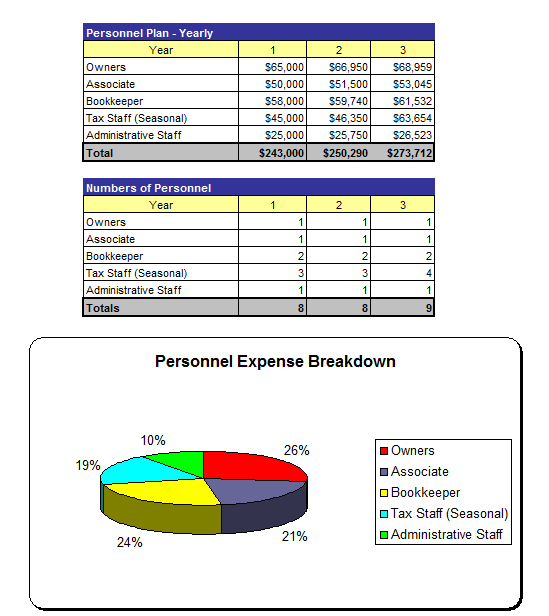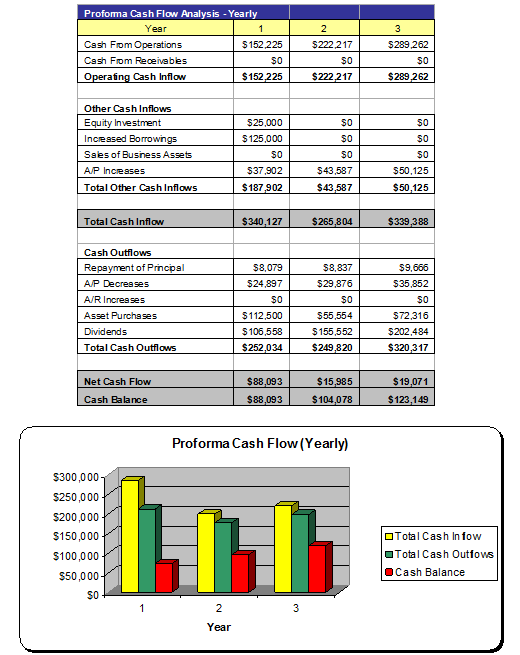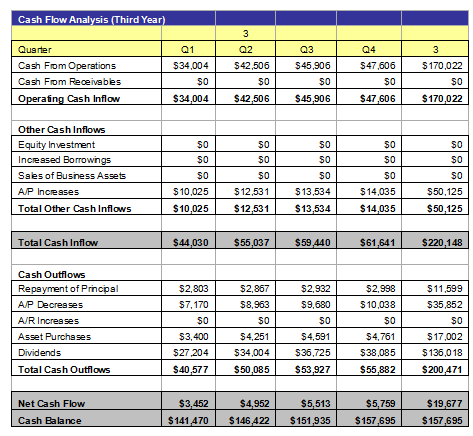Free Sushi Restaurant Business Plan
For Raising Capital from Investors, Banks, or Grant Companies!
Please note that the financials
in this complete free business plan are completely fictitious and may not
match the text of the business plan below. This free business plan demonstration
purposes only. If you are interested in purchasing the completed editable MS Word
and Excel documents for this business plan, please click the button below! Also,
the text of the business plan is formatted with a fully automated
table of contents.
Return to
Samples Page
It should be noted that there is no special software required to use these
templates. All business plans come in Microsoft Word and Microsoft Excel format.
Each business plan features:
- Excecutive Summary
- Company and Financing Summary
- Products and Services Overview
- Strategic Analysis with current research!
- Marketing Plan
- Personnel Plan
- 3 Year Advanced Financial Plan
- Expanded Financial Plan with Monthly Financials
- Loan Amortization and ROI Tools
- FREE PowerPoint Presentation for Banks, Investors,
or Grant Companies!
1.0 Executive Summary
The purpose of this business plan is to raise $175,000 for the development of a Sushi restaurant while showcasing the expected financials and operations over the next three years. The Sushi Restaurant, Inc. (“the Company”) is a New York based corporation that will develop a restaurant that will serve sushi, sashimi, and Japanese based cuisine. The Company was founded in 2008 by John Doe.
1.1 Products and Services
The Sushi Restaurant intends to serve a wide variety of entrées that will be of Japanese origin. These entrees include sushi (both platters and a la carte), sashimi, and traditional Japanese dishes. Additionally, the business will offer a wide variety of alcoholic beverages, which Management expects will generate a significant portion of the Company’s revenues and profits. The third section of the business plan will further describe the services offered by the Sushi Restaurant.
1.2 The Financing
Mr. Does is seeking to raise $175,000 from as a bank loan. The interest rate and loan agreement are to be further discussed during negotiation. This business plan assumes that the business will receive a 10 year loan with a 9% fixed interest rate.
1.3 Mission Statement
Mr. Doe’s mission is to provide customers with an outstanding line of sushi, sashimi, and Japanese cuisine dishes while concurrently remaining within the letter of the law regarding the sale of food and alcohol in the State of New York.
1.4 Mangement Team
The Company was founded by John Doe. Mr. Doe has more than 10 years of experience in the food service industry. Through his expertise, he will be able to bring the operations of the business to profitability within its first year of operations.
1.5 Sales Forecasts
Mr. Doe expects a strong rate of growth at the start of operations. Below are the expected financials over the next three years.

1.6 Expansion Plan
The Founder expects that the business will aggressively expand during the first three years of operation. Mr. Doe intends to implement marketing campaigns that will effectively target individuals within the target market of New York. Mr. Doe may also seek to increase the number of location he owns after the fifth year of operations.
2.0 Company and Financing Summary
2.1 Registered Name and Corporate Structure
Sushi Restaurant, Inc. The Company is registered as a corporation in the State of New York.
2.2 Required Funds
At this time, the Mr. Doe requires $175,000 of debt funds. Below is a breakdown of how these funds will be used:

2.3 Investor Equity
Mr. Doe is not seeking an investment from a third party at this time.
2.4 Management Equity
John Doe owns 100% of the Sushi Restaurant, Inc.
2.5 Exit Strategy
If the business is very successful, Mr. Doe may seek to sell the business to a third party for a significant earnings multiple. Most likely, the Company will hire a qualified business broker to sell the business on behalf of the Sushi Restaurant. Based on historical numbers, the business could fetch a sales premium of up to 5 to 7 times earnings.
3.0 Products and Services
Below is a description of the products offered by the Sushi Restaurant.
3.1 Sushi and Japanese Cuisine Entrees
As stated in the executive summary, the primary focus of the Sushi Restaurant will be the sale of sushi and sashimi products throughout the restaurant’s location. The Company will offer an expansive menu of Japanese cuisine, which will include non-sushi items such as grilled stir-fry and other cooked entrees. The Company will also provide a number of appetizers. The preliminary pricing schedule for the business can be found in the fifth section of the business plan.
3.2 Beverages
The Company will serve a wide variety of liquors and alcoholic beverages that are available on the menu. The specialty drinks offered by the restaurant include a number of cocktails. These drinks are primary rum, vodka, and liqueur drinks that combine a number of sweet and flavored mixes. Depending on the size and alcohols used for the beverages, prices of these cocktails range from $5 to $8 per serving. The business will also serve bottled waters, sodas, and other non-alcoholic beverages.
4.0 Strategic and Market Analysis
4.1 Economic Outlook
This section of the analysis will detail the economic climate, the restaurant industry, the customer profile, and the competition that the business will face as it progresses through its business operations. Currently, the economic market condition in the United States is in recession. This slowdown in the economy has also greatly impacted real estate sales, which has halted to historical lows. Many economists expect that this recession will continue until mid-2009, at which point the economy will begin a prolonged recovery period.
4.2 Industry Analysis
There over 600,000 restaurants and eateries in the United States. Gross annual receipts total more than $172 billion dollars per year. It is one of the country’s largest grossing industries. The industry also employs over ten million people, and generates an average annual payroll of more than $34 billion dollars per year. Among these establishments, Management anticipates that 30,000 restaurants offer sushi or Japanese as their food genre.
4.3 Customer Profile
In this section of the analysis, you should describe the type of customer you are seeking to acquire. These traits include income size, type of business/occupation; how far away from your business is to your customer, and what the customer is looking for. In this section, you can also put demographic information about your target market including population size, income demographics, level of education, etc.
4.4 Competitive Analysis
This is one of the sections of the business plan that you must write completely on your own. The key to writing a strong competitive analysis is that you do your research on the local competition. Find out who your competitors are by searching online directories and searching in your local Yellow Pages. If there are a number of competitors in the same industry (meaning that it is not feasible to describe each one) then showcase the number of businesses that compete with you, and why your business will provide customers with service/products that are of better quality or less expensive than your competition.
5.0 Marketing Plan
Mr. Doe intends to maintain an extensive marketing campaign that will ensure maximum visibility for the business in its location. Below is an overview of the marketing strategies and objectives that Mr. Doe will use once he launches his Sushi Restaurant.
5.1 Marketing Objectives
-
• Hire a public relations firm to provide reviews and articles about the Company’s grand opening.
-
• Implement a local campaign with the Company’s targeted market via the use of flyers, local newspaper advertisements, and word of mouth advertising.
-
5.2 Marketing Strategies
Mr. Doe intends on using a number of marketing strategies that will allow the Sushi Restaurant to easily target men and women within targeted market. These strategies include traditional print advertisements and discounts offered as a part of a grand opening campaign. Below is a description of how the business intends to market its services to the general public. The Company also intends on hiring a local public relations firm that will promote reviews and articles about the restaurant, its cuisine, and relevant hours of operation and pricing. Mr. Doe will invite local food critics to the Company’s Sushi Restaurant location in order to generate positive publicity about the restaurant. The Company will maintain a sizable amount of print and traditional advertising methods within local the local market to promote the sushi and Japanese cuisine products that the Company is selling. At the onset of operations, the Company will distribute an expansive number of coupons for lower priced fare within local circulars.
5.3 Pricing
In this section, describe the pricing of your services and products. You should provide as much information as possible about your pricing as possible in this section. However, if you have hundreds of items, condense your product list categorically. This section of the business plan should not span more than 1 page.
6.0 Organizational Plan and Personnel Summary
6.1 Corporate Organization

6.2 Organizational Budget

6.3 Management Biographies
In this section of the business plan, you should write a two to four paragraph biography
about your work experience, your education, and your skill set. For each owner or
key employee, you should provide a brief biography in this section.
7.0 Financial Plan
7.1 Underlying Assumptions
-
• The Company will have an annual revenue growth rate of 10% per year.
-
• The Owner will acquire $175,000 of debt funds to develop the business.
-
• The loan will have a 10 year term with a 9% interest rate.
7.2 Sensitivity Analysis
In the event of an economic downturn, the business may have a decline in its revenues. However, the Sushi Restaurant will generate substantial gross margins from its food and beverage sales, and despite a decrease in top line income, the business will be able to remain profitable and cash flow positive.
7.3 Source of Funds

7.4 General Assumptions

7.5 Profit and Loss Statements

7.6 Cash Flow Analysis

7.7 Balance Sheet
 .
.
7.8 General Assumptions

7.9 Business Ratios

Expanded Profit and Loss Statements




Expanded Cash Flow Analysis



